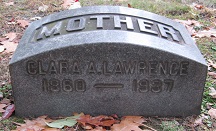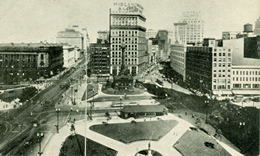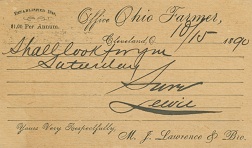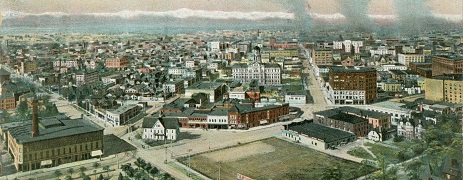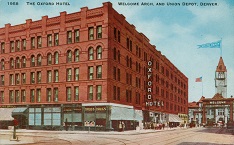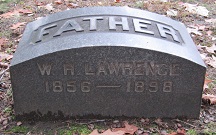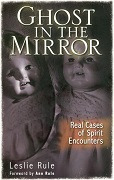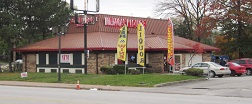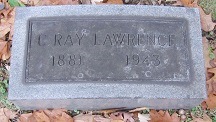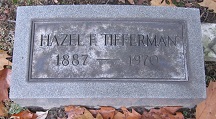
|
Clara
Alice (DeMoss) Lawrence |
|
|
|
Lake View Cemetery, Cleveland |
Clara Alice (DeMoss) Lawrence was born on Oct. 27, 1860 in Van Wert, Van Wert County, OH, the daughter of Charles W. and Eliza (Miner) DeMoss.
Her husband, a prominent newspaper publisher, met a tragic and scandalous death that generated sensational headlines. Despite this setback, she maintained a role in Cleveland society in her later years.
When Clara was seven, her father, a Civil War veteran who had not fully recovered from his wartime illnesses, passed away, leaving her fatherless. She was cared for during that difficult time by her grandfather Burget Miner.
Clara's mother remarried again to William Cornwell, when Clara was age 12. Shortly thereafter, Clara and her mother, stepfather and siblings migrated westward to Nebraska, settling in Columbus, Platte County. To her mother, Clara was known as "Alice."
On March 10, 1880, at the age of 20, Clara married 28-year-old newspaper man William Henry Lawrence (1852-1898), a native of Wakeman, Huron County, OH, of a prominent publishing family of Cleveland, OH. He was the youngest of 10 children of English immigrant John Horatio Lawrence and his wife Sarah (Evans) Lawrence of Lockport, NY. The ceremony took place in Columbus, NE, by the hand of J.J.A. Flehartz, pastor of the Methodist Episcopal Church. News of the union was published in the Platte County Journal and Columbus (NE) Journal.
|
|
|
Cleveland's public square |
The Lawrences produced a family six children, of whom five grew to adulthood – Claude Ray "Jack" Lawrence, William Kalamazoo Lawrence, George Roland "Roll" Lawrence, Hazel Frances Tuttle Tifferman and Clara DeMoss Hayward.
Sadly, the family lost an infant son, named "Baby Dear," on Jan. 31, 1895, at the age of 43 days.
Son Claude was born in Lincoln, NE in 1881, the only one of their offspring to enter life there. Upon returning to Cleveland from Nebraska, the young Lawrence family resided at 286 Genessee Avenue, and the rest of the children were born in Cleveland.
William had grew up in a family that was rocked by divorce when he was only age four. The father "left the mother without a cent of money and eight children...," said the History of Cleveland, Ohio. "With the brave and unquenchable spirit that only a mother shows, she did carpet weaving and other work that she might support the family...." William's brother Mortimer, who was older by nine years, "worked for many days at ten cents a day and board, and well remembers with what pride he took home to his mother his first dollar -- the earnings of ten day's hard work. With close economy the family managed to meet expenses and the children attended the public school for two or three months in a year, their financial condition becoming easier as the other children grew and were able to provide at least in part for their own needs." How William found his way to Nebraska and met our Clara is not yet known.
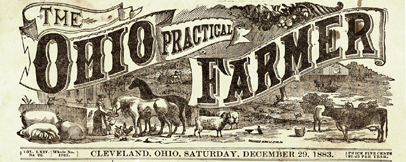 |
| 1883 issue of the Ohio Farmer, featuring a fanciful masthead |
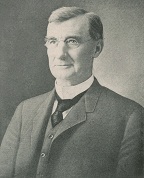 |
| William's brother and boss, M. J. Lawrence |
From 1872 to 1894, William's brother Mortimer, a veteran of the Civil War, was the primary publisher of The Ohio Practical Farmer, sometimes just known as The Ohio Farmer, a prominent and influential newspaper that still exists today as a magazine. He purchased the newspaper in 1873 from its previous owner, G.E. Blakelee. The New York Times once reported that Mortimer "took hold of the Ohio Farmer years ago, when it was of no account, and built it up to a good paying property. he is a Knight Templar, and stands very high in the community." A complete set of hardcopies of back issues of The Ohio Farmer is held at the Ohio Historical Society's Archives/Library in Columbus.
In the first issue under family control (Jan. 4, 1873), Mortimer made a promise to his readers:
In assuming this important trust I have simply to say that I shall endeavor to the best of my ability to make it fully worthy of the public's trust and patronage and to add to its already enviable reputation. I mean to make it a success, fully appreciating the necessity of conducting it in such a manner that its value will be seen and appreciated by its readers and patrons. He who caters to the intellectual tastes of the American people, with a hope of success, must show genuine value in his product or have his hopes blighted; for the reading people of our country today possess too much intelligence and are too critical to be expected to support anything but a first class journal...
William moved into his brother's firm as time went on. Their partnership, formed in 1886, was known as M.J. Lawrence & Bro., with Mortimer serving as editor, and William as vice president and business manager. But William never achieved his brother's success, and always seems to have been in his shadow.
|
|
|
Ohio Farmer mailing card, October 1890 |
Mortimer and his son Lyman also established another business, Lawrence-Williams Company, which served as the exclusive selling agent in the United States and Canada for a French-made veterinary medication known as Gombault's Caustic Balsam. In 1888, Mortimer traveled to Denver and with several other investors founded the People's Savings and Deposit Bank. The bank opened on July 9 of that year, with Charles A. Raymond named as its president, and it was mentioned in the 1918 book, History of Colorado, Volume 1, edited by Wilbur Fiske Stone.
Mortimer once wrote this about his brother:
[He] was personally known to a large number of our subscribers and patrons.... While his faults were many, all of us who knew him best cherish the knowledge that his business honor, his truthfulness and loyalty to friends can never be questioned. His charity for the poor and ready assistance and sympathy for the unfortunate or afflicted, knew no bounds. He was kind and liberal to a fault and fearless to an extent that knew no danger, and in emergencies made him reckless of consequences.
Circa 1878, the Ohio Farmer had a circulation of 25,000 weekly subscribers in more than 4,500 post offices in Ohio, New York, Pennsylvania, West Virginia, Kentucky, Indiana, Michigan and states in the west. "No swindling, deceptive, or quack advertisements inserted at any price," it advertised.
The effort was lucrative, as William became wealthy enough to purchase a private ranch in Denver, CO. (Seen here is a rare old bird's eye view of Denver, from a postcard of that era, taken from the state capitol building.) Colorado was a popular destination for prominent Clevelanders of that era, and Standard Oil founder and billionaire John D. Rockefeller and his family are known to have vacationed there in the 1870s. In fact, M.J. himself launched business ventures in Denver -- including the People's Savings and Deposit Bank in 1888 and later the People's National Bank.
|
|
|
Denver, Colorado |
Clara traveled to Denver in the summer of 1892 and upon her return home stopped in Nebraska to see relatives in the town of Columbus. Reported an article in the Columbus Journal (Aug. 24, 1892):
Mrs. William Lawrence of Cleveland, Ohio, stopped in the city over Sunday. In her girlhood she was a resident of this city, and will be remembered as Alice DeMoss. Her sister, Mrs. Etta Wake, of Schuyler, was also visiting friends in the city over Sunday. Mrs. Lawrence was on her return from Denver, where she had been the past three weeks.
But the marriage was deeply troubled. In the summer of 1894, Clara filed for divorce. An article in the Cleveland InterOcean, reprinted in the Independence Day 1894 edition of her old hometown newspaper, the Columbus Journal, said that:
It is almost incredible that there could be so much change in people as the following would indicate. Wm. Lawrence and Alice DeMoss, known to quite a large circle of Journal readers, seemed all the world to each other when they were here, years ago. A nicer young lady you would scarcely ever see, and Lawrence seemed all right.... Mrs. Lawrence accuses her husband of the grossest kind of cruelty, alleging that he has assaulted her on average of forty or fifty times a year, blackened her eyes on Christmas Day, bruised her head against a register, and otherwise made her life a burden. Once, she says, he chased her through the house to throw her from an upper window, but she escaped by running down the back stairs. Last Thursday, Mrs. Lawrence asserts, she was out driving with her husband, and because she would not hold the horse in front of a saloon while he went in and took a drink he swore at her so terribly that she left the vehicle. He followed her in the buggy, swearing at and abusing her, and at Erie street deliberately tried to run over her. On Murison street he jumped out of the buggy and began to drag her along the street, thus attracting a crowd. As a result of this they separated. Lawrence is worth $250.000."
William continued to work until ill health forced him to resign in about 1894. The issue of Sept. 19, 1895 is the last one where he was listed as vice president of the company.
|
|
|
Denver hotel where William was killed |
After his resignation, and estranged from his family, William traveled "through the south and west," said the Cleveland Plain Dealer, while his wife and five children remained in Cleveland. He continued to use his title of "Editor" of the Ohio Farmer as evidenced by a testimonial he wrote in 1898 that was published in Ayer's Almanac, touting the instant relief he had experienced when using Ayer's Cherry Pectoral, a patent medicine for throat and lung ailments.
His traveling companion was the troubled but "exceedingly beautiful" Florence (Chisholm) Richardson, "at one time a member of Cleveland's demimonde." Florence was divorced, and had once been arrested for robbing a musician in Cleveland. She also was "an expert rifle shot, having received instructions in handling the weapon from [William] and having won [a] championship cup..." The Denver Post said both had been hard drinkers and that she "used morphine continually."
In April 1898, William went to the ranch in Denver and took Florence with him. In September of that year, they registered for a stay at the Oxford Hotel in Denver and got settled in Room 306. There, they got into a dispute, and William threatened that he was leaving her to return to his family.
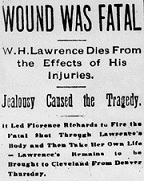 On
Friday, Sept. 9, the fiercely jealous Florence got her grisly revenge. She pulled out a .38 caliber
revolver, took aim, and fired at William. The shot hit him "in the
lung..., and the ball passed through his body," said the Plain Dealer.
"Immediately after shooting [him] she turned the weapon upon herself with
fatal results. She died immediately."
On
Friday, Sept. 9, the fiercely jealous Florence got her grisly revenge. She pulled out a .38 caliber
revolver, took aim, and fired at William. The shot hit him "in the
lung..., and the ball passed through his body," said the Plain Dealer.
"Immediately after shooting [him] she turned the weapon upon herself with
fatal results. She died immediately."
The mortally wounded William staggered out of the room, into the hall and collapsed with a groan. He was taken from the hotel to St. Luke's Hospital in Denver, where he held on for two days. His wound hemorrhaged blood into his lungs, which then clotted causing congestion he could not overcome.
Telegrams were sent to his wife and brother M.J. in Cleveland. One telegram said he "was improving and on the strength of it his wife was preparing to go to his bedside. She was just about to leave her home to take the train for Denver when the telegram announcing his death was received." William's nephew Lyman Lawrence finally agreed to go to Denver to bring the body back to Cleveland.
The sensational story made headlines in the Denver Post and Cleveland Plain Dealer and was mentioned in the New York Times. Love letters William had sent to his lover were published in local newspapers. The news even was included in periodicals such as The Breeder's Gazette.
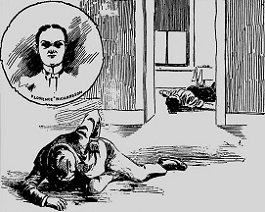 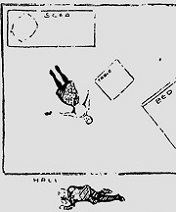
|
|
Death scene as sketched in the Denver Post, with Florence pictured at top left |
The funeral was held at the Demoss home. Burial was in Cleveland's prestigious Lake View Cemetery.
|
|
|
Lake View Cemetery |
 With
"extreme sadness," The Ohio Farmer published the following
eulogy:
With
"extreme sadness," The Ohio Farmer published the following
eulogy:
The grief that attends his untimely death is deepened by the memory of his many manly qualities. These we shall always cherish, while we cover his faults with the mantle of charity. All of the many old employes of The Farmer sincerely mourn his sad ending and deeply sympathize with his wife and children in their bereavement and sorrow.
The Lake View Cemetery was created in 1869 as a garden-style park "designed for the living" who could heal from grief among lovely gardens, picnics by the duck pond, visit loved ones and promenade in their Sunday finest. It features classic botanical displays and designs produced by award-winning landscape architects and a team of horticulture experts. Among other notable Americans, the Rockefellers, assassinated U.S. President James A. Garfield and famed crime fighter Eliot Ness are buried at Lake View.
Clara thus was widowed unexpectedly at age 38 and in a most humiliating way. The eldest of her five children was 17 years old at the time, and the youngest eight.
Fortunately, Clara inherited her husband's wealth and was able to live comfortably from the proceeds for the remainder of her years.
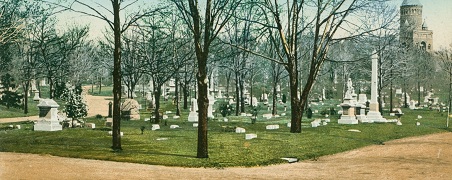
|
|
Lake View Cemetery, Cleveland, circa 1906 |
Circa 1900, when the federal census was enumerated, Clara and her children Hazel, George and Clara resided on Euclid Avenue in Cleveland.
When Clara's grandfather, Burget Miner was old and inform, he came to Cleveland in about 1902 to reside in her home. He died there on March 31, 1909, and his body was returned to Van Wert for burial. Clara was the informant on his death certificate.
Clara moved to a new address in about 1902 and stayed there for the remaining 35 years of her life. The home was at 13613 Euclid Avenue in East Cleveland. Among her Euclid neighbors -- many blocks away -- were the Rockefellers. "Local boosters had ... tagged Euclid Avenue 'the most beautiful street in the world,' with homes that lavishly mirrored the local fortunes in oil, iron, banking, timber, railroads and real estate," writes Ron Chernow in his national bestseller, Titan: The Life of John D. Rockefeller Sr. "All of the town's new opulence was reflected in this street of massive houses."
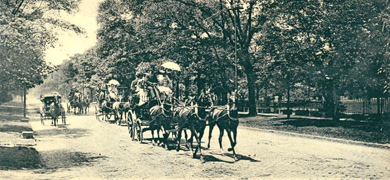 |
|
Carriages on leafy Euclid Avenue where the Lawrences resided |
 In 1910, Clara paid for a biographical profile of her
grandfather Burget Miner to be included in the book, A History of Cleveland,
Ohio. Compiled by
Samuel P. Orth and printed by S.J. Clarke Publishing Company, the book features
a chapter on Burget in Volume III, pages 912-913. Profiles also featured Clara's
brother in law Mortimer J. Lawrence and his son Mortimer William Lawrence.
In 1910, Clara paid for a biographical profile of her
grandfather Burget Miner to be included in the book, A History of Cleveland,
Ohio. Compiled by
Samuel P. Orth and printed by S.J. Clarke Publishing Company, the book features
a chapter on Burget in Volume III, pages 912-913. Profiles also featured Clara's
brother in law Mortimer J. Lawrence and his son Mortimer William Lawrence.
|
|
|
Book telling William's murder story, 2008 |
In short, Burget's bio in the History of Cleveland is a whitewashing of his life. It begins with a bold untruth -- "Burget Minor was a native of Connecticut, but after leaving New England went to Maryland..." -- directly contradicting his death certificate which Clara herself signed a few years earlier. Since Burget only lived in Cleveland for just seven years at the end of his life, there is no reason why he should be featured in this work, other than to burnish Clara's own reputation. While purely speculation by this website's founder, Clara may have done this to cover up the fact that Burget was German, at a time when there was much anti-German sentiment in the United States just a few years before the outbreak of World War I. Through the lie that he was from Connecticut, she may have been trying to enhance her own standing among her society friends by creating the perception that she was from the prominent English family of Miner-Minor that had been in New England since the 1600s. The actual facts behind this will never been known.
The 1910 census shows Clara heading the household on Euclid Avenue, with sons Claude, William and George, as well as widowed daughter Hazel Tuttle, age 24. Also living under the family roof was Clara's coachman, Lucius Smith. By 1920, she was living alone.
At some point in time, date unknown, Clara's younger half brother Archie B. DeMoss traveled from his home in Kansas to Cleveland to see her. The only known reference to this interaction is a letter from a Cornwell cousin to Archie's son, stating that Clara "was so elderly at the time of your father's visit."
The 1930 census shows Clara and divorced son Claude living in the Euclid Avenue home. Despite the Great Depression having crippled the American economy, Clara claimed an estate valued at $80,000 at the time.
|
|
|
13613 Euclid Avenue today |
When she became ill later in life, Clara sold her Euclid Avenue home to the Joseph J. Margowsky Funeral Co.
Clara passed away at the age of 76 on Jan. 21, 1937 in Cleveland City Hospital. She had suffered from diabetes and hardening of the arteries, as well as dementia. She was buried beside her husband, after nearly four decades as a widow. Her brief obituary was published in the Cleveland Plain Dealer.
The story of William's tragic death was retold in the 2008 book, Ghost in the Mirror: Real Cases of Spirit Encounters, authored by Leslie Rule.
Circa 1965, the funeral home at the site of Clara's former home operated under the name "Dougherty Funeral Parlors." It later was demolished to make way for a Pizza Hut. Today the former pizza building, on a 0.69-acre trace, serves as a liquor and fast-cash store.
~ Son Claude "Ray" Lawrence ~
|
|
|
Lake View Cemetery |
Son Claude "Ray" Lawrence (1881-1943) was born on Feb. 22, 1881 in Lincoln, NE.
He was of medium build and height, with blue eyes and light hair. Claude attended Western Reserve Academy in Cleveland, where he played baseball and graduated in 1901.
In 1910, at the age of 29, Ray lived with his widowed mother in Cleveland and had no occupation.
He married Evelyn M. (?) in about 1916, at the age of 35. When Claude registered for the military draft during World War I, in September 1918, he lived in Dayton, Montgomery County, OH, where he was a manager with the Fiske Rubber Company.
Sadly, by 1930, he was divorced. When the 1930 census was taken, Claude was 49, and was employed as a real estate salesman and made his home with his widowed mother. Later, in his early 60s, he resided at 7722 Linwood Avenue in Cleveland.
Claude suffered from lung cancer, and died of its effects at the age of 62, on Sept. 6, 1943, at the McGillis Sanitarium in Cleveland. Burial was in the family plot at Lake View Cemetery.
~ Son William Kalamazoo Lawrence ~
Son William Kalamazoo Lawrence (1884-1953) was born on Sept. 6, 1884. He was of medium height and build, with blue eyes and light hair.
At the age of 26, in 1910, he lived with his widowed mother in Cleveland, and had no occupation.
The following year, on Oct. 11, 1911, William married 25-year-old Charlotte A. Clark (1886- ? ), the daughter of Jerry and Eva S. (Sivella) Clark, and a native of Dayton, Montgomery County. At the time, William gave his occupation as "real estate" and his address as 13325 Euclid Avenue. Rev. J.C. Jagar performed the nuptials.
In September 1918,.as World War I was drawing to a close, William was required to register for the military draft. He stated his occupation as advertising manager for the Cleveland Telephone Company. He was married, and they lived at 12704 Irvington in Cleveland.
He later married Lulu (?) and resided in Los Angeles, where he died on Jan. 16, 1953.
|
|
|
Lake View Cemetery |
~ Son George "Roland" or "Roll" Lawrence ~
Son George Roland "Roll" Lawrence (1889-1965) was born on April 28, 1889 in Cleveland. As an adult, he was tall and of medium build, with blue eyes and brown hair.
George was employed as a clerk in Cleveland in 1910.
At the age of 26, on April 5, 1916, he married 26-year-old Loretta Mary Henderson (1889-1951), the daughter of Joseph and Elizabeth (Altmayer) Henderson, and a native of Sharpsburg, near Pittsburgh, PA. The nuptials were solemnized by Rev. John F. Keene in Cuyahoga County. At the time, Roland was a salesman, and lived at 13325 Euclid Avenue, while Loretta resided in Cleveland at 823 East 149th Street.
By June 1917, when he registered for the military draft during World War I, Roland was employed as a collector for the Crowell Publishing Company in Cleveland, located at 1118 Schofield Building. He made his home in 1917 at 651 East 118th Street in Cleveland.
By 1930, Roland and Loretta lived on East 124th Street in Cleveland, where he was employed as a "credit man" for a sewing machine company. In the early 1950s, they made their home at 7714 Linwood Avenue.
Sadly, Loretta died in Lakeside Hospital in Cleveland on Feb. 3, 1951, at the age of 61. She was cremated and laid to rest in Highland Cemetery in Cleveland. George's signature on her death certificate was very shaky.
Roland spent the remaining 14 years of his life as a widower. He passed away at the age of 76 in Cleveland on Jan. 22, 1965. His ashes rest with his wife's today in Cleveland's Lake View Cemetery.
~ Daughter Hazel Frances (Lawrence) Tuttle Dickey Mellert Tifferman ~
|
|
|
Lake View Cemetery |
Daughter Hazel Lawrence (1887-1970) was born in 1887. She was age 11 when her father was killed, and in her lifetime she was married four times.
In May 1905, when she was age 17, Hazel filed a $300,000 lawsuit against her uncle Mortimer J. Lawrence, alleging assault of some sort. In reporting on the story, the New York Times noted that her uncle "is at present supposed to be cruising on his steam yacht in West Indian waters, but no definite knowledge of his whereabouts has reached Cleveland."
Her first husband was (?) Tuttle. Tragically, he died after only a year or two of marriage. Hazel moved back into her mother's home on Euclid Avenue in Cleveland, living there as of 1910.
She then married (?) Dickey. The marriage did not last, and a divorce was issued by the Cuyahoga County Clerk (case #5405).
On Nov. 26, 1919, at the age of 30, Hazel wed 30-year-old Fred J. Mellert (1888- ? ), of 2604 Barber Avenue. Rev. W.W. Bustard and Rev. Dan F. Bradley performed the nuptials. Born in Cleveland, the son of Vincent and Catherine (Delzer) Mellert, Fred was employed as a "Trimmer." At the time, she lived at 13613 Euclid Avenue.
|
|
|
Lake View Cemetery |
Hazel and Fred made their home on Carnegie Avenue in Cleveland, where they appear in the 1920 federal census. His occupation was given as "window cleaner" for buildings. Boarding in their home were three lodgers -- laborers Joseph Spitzer and Earnest Seibert and interior wallpaper hanger Joseph Kulke. The marriage lasted for eight years, but the couple divorced in 1927.
After 10 years as a single woman, Hazel wed machinist Arthur Tifferman (1889-1951), son of William and Albertina (Bentson) Tifferman. The ceremony was held on Dec. 17, 1937 in Cuyahoga Heights in Cleveland, by justice of the peace Frank E. Hanousek, when Hazel was age 50 and Arthur 48. At the time, Hazel made her home at 7722 Linwood Avenue in Cleveland, while Arthur lived at 7712 Melrose Avenue. Arthur had been married once before, and was divorced in that marriage in 1922. He also was a World War I veteran, having served as a private in the 104th Infantry of the 26th Division.
The couple resided at Hazel's home at 7722 Linwood Avenue in Cleveland. Suffering from cancer of the rectum, Arthur passed away at the age of 62 on July 23, 1951. His remains were cremated.
Hazel died on Sept. 23, 1970, at age 82. She was placed into eternal rest beside her husband Arthur in the Lawrence family plot at Lake View Cemetery.
~ Daughter Clara DeMoss (Lawrence) Hawley Hayward ~
Daughter Clara DeMoss Lawrence (1890-1966) was born in 1890 in Cleveland.
At age 19, she married 28-year-old Lee Carroll Hawley (1881- ? ), a native of Nevada County, CA, and employed in Cleveland as a foreman. He was the son of O.F. and Anna (Carroll) Hawley. The ceremony, held on Nov. 15, 1909, was led by Rev. McFadden of Euclid Avenue, and possibly also by Rev. John H. Blackburn.
They had three known children -- Louise C. Mellon, Helen J. Hawley and Jack F. Hawley, all born in Ohio.
When the 1910 census was taken, the Hawleys made their residence in Lakewood, Cuyahoga County. Lee continued his work as a foreman in a carbon manufacturing plant.
Sometime between 1915 and 1920, Clara and Lee moved to Southern California, settling in Santa Paula, Ventura County. Their home in 1920 was on North Eighth Street. Lee apparently had given up his industrial profession, and considered himself as a farmer.
The Hawleys' marriage fell apart during the 1920s. In about 1928, Lee married again, to Miriam (?) (1904- ? ), who was 23 years younger than he.
Clara wed James R. Hayward (1880?- ? ), a native of Illinois. They resided in 1930 on South Spalding Drive in Beverly Hills, Los Angeles County. Clara's children Helen and Jack lived in their home that year, while another offspring, James' "step-daughter" Maxine and her husband Max Kunz, also resided under their roof. James' occupation in 1930 was as a manager of a retail grocery.
In 1937, Clara lived with her divorced sister Hazel at 7722 Linwood Avenue in Cleveland.
Later, she returned to California, and made her home in Ventura. She died on Jan. 24, 1966, at the age of 76.
Granddaughter Louise C. Hawley (1910-2003) was born on June 1, 1910. She was a 1927 graduate of Santa Paula Union High School. She is believed to have married (?) Mellon. In October 2000, she made news in the Santa Paula (CA) Times when, at the age of 90, she attended a high school reunion drawing a crowd of more than 300 attendees. She died in Oxnard, Los Angeles County, CA on Nov. 24, 2003. Interment was in the Holy Cross Cemetery and Mausoleum in Culver City.
Granddaughter Helen J. Hawley (1913- ? )
Grandson Jack F. Hawley (1914-1988?) was born on June 21, 1914, in Cuyahoga County. He is believed to have died in Santa Paula, Ventura County, CA on July 3, 1988.
~ More on the Lawrences ~
William's brother Mortimer J. Lawrence also founded the Michigan Farmer and Pennsylvania Farmer publications. He tapped his son Mortimer William Lawrence -- said to have been "a man of exceptional ability and at the same time peculiarly agreeable personality, warm-hearted, generous, broad-minded, 'easy-going' in the thoroughly good sense of that expression," said The Country Gentleman -- to serve as general manager of the Ohio Farmer After the son's untimely death in 1909, at the age of 36, the father made the decision to sell all three publications, and did so to Senator Arthur Capper of Kansas in January 1922.
In October 1900, another brother, J.H. Lawrence, was shot and killed in Denver by farmer Henry Dillman. Said the Denver Post, "The trouble arose in a dispute over water rights, and in the heat of the dispute Dillman drew a revolver and fired at Lawrence, killing him almost instantly.... the two men are both prominent farmers and citizens of the community. Lawrence lived in the town of Brighton and Dillman lives on his farm a mile west of the village."
|
Copyright © 2001-2004, 2006, 2009, 2011, 2013-2014 Mark A. Miner |
|
Many thanks to Audrey (Landreth) Le Mieux for sharing material for this page. |
